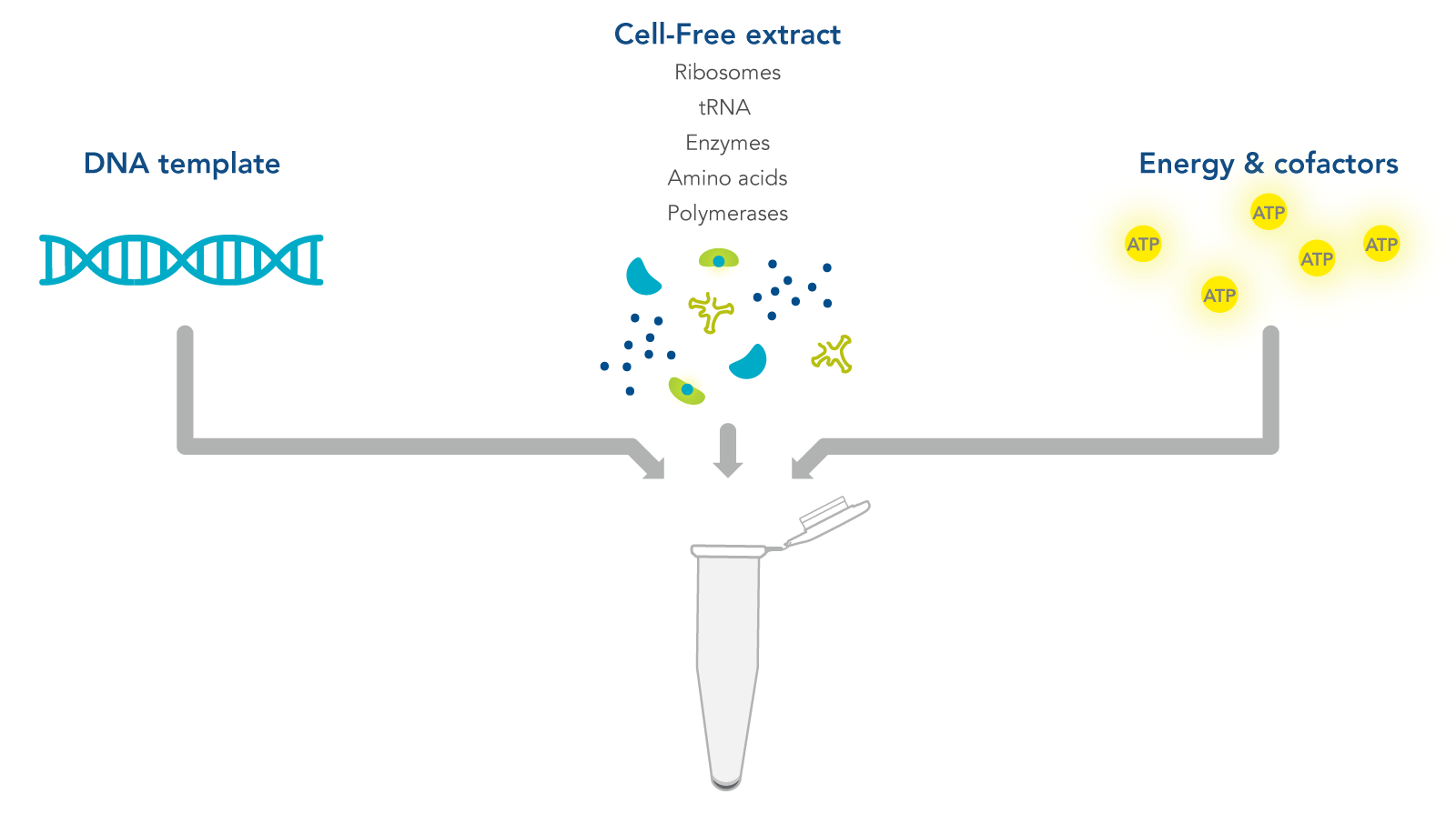Cell-Free Protein Synthesis
Overview
In the realm of drug discovery, scientists are constantly seeking innovative ways to accelerate the process of identifying potential therapeutic targets and developing new drugs. One such innovation that has gained momentum in recent years, now common place in synthetic biology, is cell-free protein synthesis (CFPS). This cutting-edge technique offers a versatile and efficient platform for generating proteins outside of living cells, opening up exciting opportunities for drug development. This article will discuss what Cell-Free Protein Expression is, its significance in the field of drug discovery and how IDT helps researchers who are using this method.

The Basics of Cell-Free Protein Synthesis
Cell-free protein expression, often referred to as in vitro protein synthesis, is a technique that enables the production of proteins in a controlled environment outside of living cells. Unlike traditional cellular expression systems (e.g., bacterial, yeast, or mammalian cells), cell-free systems extract the cellular machinery necessary for protein synthesis and place it in a test tube or reaction vessel as shown in Figure 1. These systems are comprised of three fundamental components:
- Cell-Free Extract: This is the heart of the system, containing the essential cellular components for protein synthesis, such as ribosomes, tRNA, amino acids, and enzymes. The source of the extract can vary, with commonly used ones including E. coli, rabbit reticulocyte, and wheat germ extracts.
- DNA Template: Researchers provide the genetic information for the desired protein in the form of a DNA template. This template typically contains a promoter sequence to initiate transcription and a coding sequence for the target protein.
- Energy and Cofactors: Energy sources (e.g., ATP, GTP) and cofactors (e.g., magnesium ions) are supplied to facilitate transcription and translation processes.
Advantages of Cell-Free Protein Synthesis
Cell-free protein synthesis offers several advantages that make it an attractive tool for drug discovery:
- Rapid protein production: Cell-free systems can produce proteins in a matter of hours, allowing for quick screening of potential drug targets and candidate molecules.
- Flexibility: Researchers can fine-tune the reaction conditions to optimize protein yield and functionality, making it suitable for a wide range of proteins, including difficult-to-express ones.
- Budget friendly: With no need to maintain living cells and increased protein yields, cell-free systems are often more cost effective than in vivo systems.
- Easy incorporation of labels: It is straightforward to incorporate isotopic or fluorescent labels into the expressed proteins, enabling various downstream assays and structural studies.
- Minimal contamination: Since cell-free systems lack living cells, there is no risk of contamination by endotoxins or other cellular debris, simplifying downstream purification processes.
Limitations to Cell-Free Protein Synthesis:
- Limited post-translational modifications depending on the system used.
- Low protein yields in some instances.
- Lack of endogenous membrane structures depending on the system used.
Applications in Drug Discovery
Cell-free protein synthesis has found numerous applications in the drug discovery pipeline:
Target Identification and Validation
In the early stages of drug discovery, researchers often need to identify and validate potential drug targets. Cell-free expression allows for the rapid generation of target proteins, facilitating high-throughput screening assays to assess their suitability as drug targets.
Hit-to-Lead Optimization
Once a promising drug target is identified, cell-free systems aid in the optimization of lead compounds. Researchers can use cell-free expression to produce target proteins for binding studies, enabling the assessment of compound binding affinity and selectivity.
Protein Engineering
In the quest for more effective drugs, protein engineering plays a crucial role. Cell-free expression systems enable the generation of mutant or modified proteins for structure-activity relationship studies and the development of biologics.
Antibody Production
The production of monoclonal antibodies, a vital class of therapeutics, benefits greatly from cell-free protein expression. This method allows for the rapid and cost-effective production of antibodies for research and therapeutic purposes.
Structural Biology
Cell-free expression systems are valuable in structural biology studies. Expressed proteins can be used for X-ray crystallography, NMR spectroscopy, and cryo-electron microscopy, providing insights into the three-dimensional structure of proteins and potential drug binding sites.
As cell-free protein synthesis has gained popularity, the technique has continued to evolve to improve its ease and versatility. One example of an advancement that simplifies the workflow and can increase its scalability is IDT’s gBlocks HiFi Gene Fragments. With NGS-verified, clonal fragments from 1000–3000 bp, researchers can obtain high-quality template without the trouble of cloning and sequencing.
Overall, cell-free protein synthesis has emerged as a powerful tool in the quest to develop novel therapeutics, offering speed, flexibility, and precision. This innovative technique continues to push the boundaries of what is possible in the quest to discover new drugs and improve human health.
Request a consultation
Working on protein or enzyme engineering? Your time is valuable and we’ll prioritize your inquiry. Click on “Request a consultation” to provide brief information about your project, and we’ll be in touch to discuss it ASAP.
Request a consultationRelated technologies
Products for Protein Synthesis and Engineering
References
- Zemella A, Thoring L, Hoffmeister C, Kubick S. Cell-Free Protein Synthesis: Pros and Cons of Prokaryotic and Eukaryotic Systems Chembiochem. 2015;16(17):2420-2431.
- Batista AC, Soudier P, Kushwaha M, Faulon JL. Optimising protein synthesis in cell-free systems, a review Eng Biol. 2021;5(1):10-19. Published 2021 Feb 21.
- Dondapati SK, Stech M, Zemella A, Kubick S. Cell-Free Protein Synthesis: A Promising Option for Future Drug Development BioDrugs. 2020;34(3):327-348.
- Garenne, D., Haines, M.C., Romantseva, E.F. et al. Cell-free gene expression.Nat Rev Methods Primers. 2021; 49(1).
- Dondapati SK, Stech M, Zemella A, Kubick S. Cell-Free Protein Synthesis: A Promising Option for Future Drug Development. BioDrugs. 2020;34(3):327-348.
- Xie X, Yu T, Li X, et al. Recent advances in targeting the "undruggable" proteins: from drug discovery to clinical trials Signal Transduct Target Ther. 2023;8(1):335. Published 2023 Sep 6.
